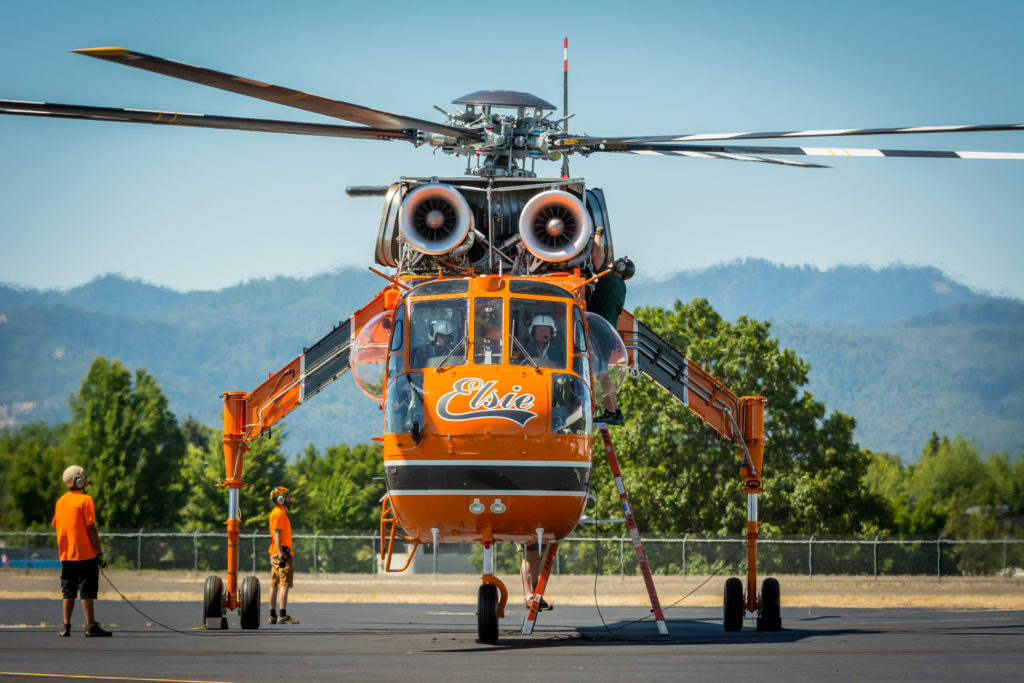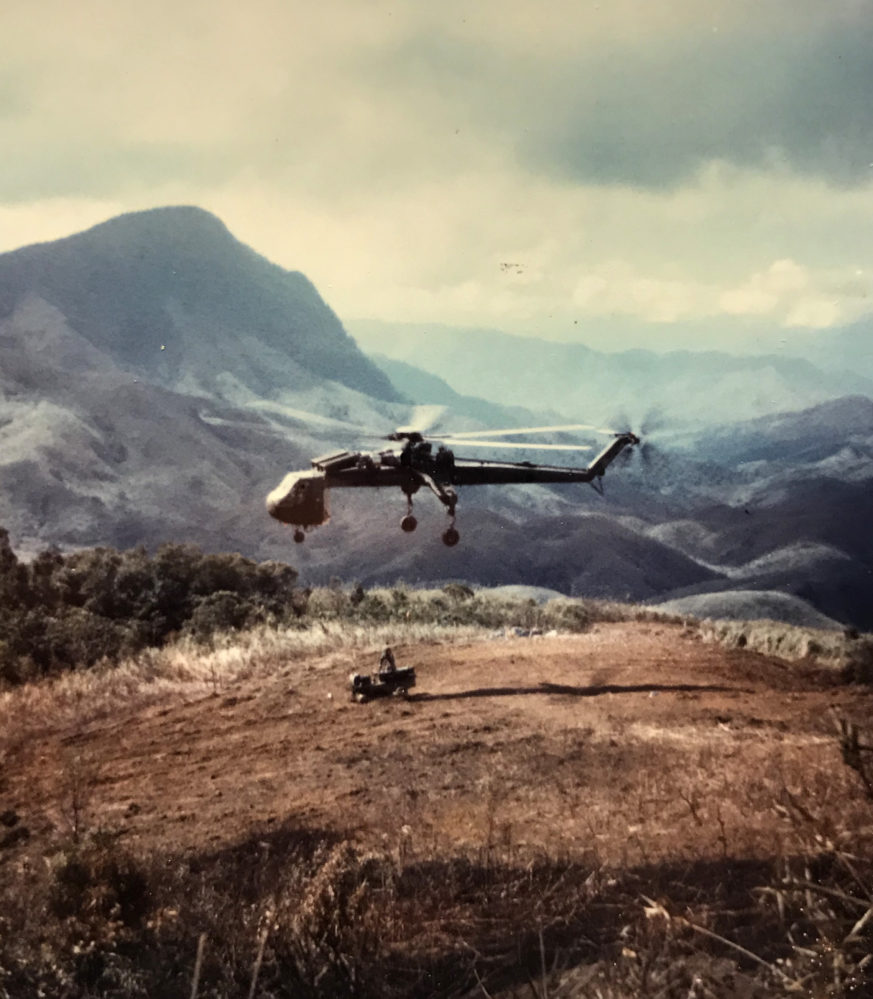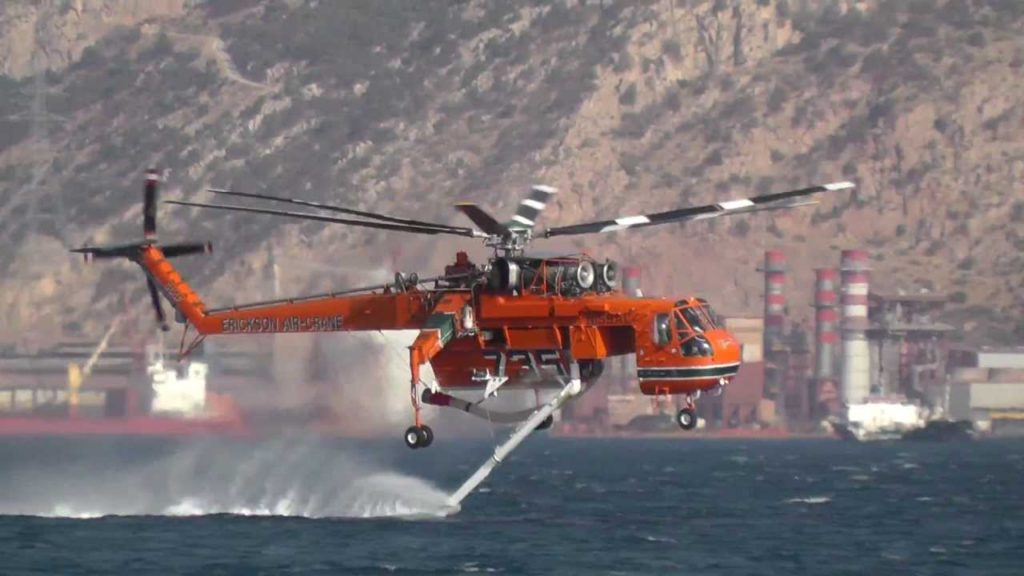In celebration of Erickson’s 50th anniversary, learn more about the original equipment manufacturer and its first aircraft.
By Jennifer Ferrero
The S-64 Air Crane® Helicopter was never meant to transport people. The aircraft, from the beginning, was made to lift heavy objects. With seating for three pilots only, it is a focused and unique piece of equipment. The S-64 Air Crane® helicopter has a fascinating story because there is nothing else like it in the world.

Is it a bird, a plane, a bug? These are common questions people ask when they see the S-64 Air Crane® helicopter. Sometimes people see the aircraft and immediately think of aerial firefighting. Perhaps they’ve seen the aircraft flying in the mountains dropping water over a wildfire. But in other cases, it is a spectacle to see it because it lacks a fuselage, is bright orange, and resembles a giant cricket, or praying mantis, or some other kind of odd bug.
The fact is that the S-64 does have a broad reach of roles in the world, and at the same time, it has brand recognition. Erickson Incorporated’s business has been able to save lives and property worldwide. The stories about the missions and work conducted by the S-64 communicates stunning accomplishments.
In fact, back when it was new, much of the heavy-lift objects that the S-64 Air Crane® helicopter would move, relocate, or lift, in today’s world, didn’t exist. From power lines to television antennas to bridges, and HVAC systems on massive warehouse-style buildings, these were smaller-scale, less robust, or non-existent back in the early 1970s when this all started.
When originally purchased by Erickson founder, Jack Erickson, the helicopter came from Sikorsky and was called the S-64 Skycrane. To this day, some people still call it that. The purpose for Jack Erickson in purchasing the aircraft was to load timber off the mountains. He wanted a way to get to the top of mountains to carry heavy loads without big trucks tearing up the wilderness. Erickson’s father owned a logging company, which is how Jack came to be in the logging business.
A friend of Erickson’s, Wes Lematta, who later started Columbia Helicopters, also wanted to be involved with helicopter logging. They started their logging discussion using the Boeing 234, a large double rotor helicopter. The men are generally known as the inventors of heli-logging. Except, as the industry developed, Erickson continued to use the Sikorsky Skycrane, and Lematta continued to use the Boeing 234. The Boeing helicopter could carry 20+ passengers, whereas the Skycrane has no fuselage and is not meant to carry passengers.

The Skycrane was the aircraft of choice for Erickson as he began to develop his business.
With the precision placement aft seat, and the two pilot seats, the applications for the helicopter kept growing. Luckily Jack Erickson is an entrepreneur, and inventor, and was not risk adverse. He plunged headlong into what has now become a 50-year-old business. Call it tenaciousness, or a bit of luck, but there was a lot that people could see the S-64 Air Crane® helicopter doing.
So much so, that when Erickson got to the point where he thought, this is an amazing piece of equipment and I need more, he felt compelled to approach Sikorsky to buy the rights to manufacture new S-64 Air Crane® helicopters, to make parts and support existing owners.
Sikorsky at the time had invested in the aircraft but had other irons in the fire. They determined that they didn’t want to continue to be the original equipment manufacturer (OEM) for the Skycrane. They sold Erickson the Type Certificate in 1992 to become the OEM for the aircraft, and the S-64 Air Crane® helicopter was created.
Over the years, pilots of the S-64 Air Crane® helicopter have typically received military training or have served in civilian capacities and have flown the Chinook or other similar aircraft before coming to Erickson to fly the S-64. Erickson’s Chief Pilot, Justin Rath said, “Typically, a lot of S-64 pilots come from the civilian, utility helicopter community, but we do have a handful of pilots that have transitioned over from the military quite successfully. Pilots with multi-crew, heavy helicopter and vertical reference experience is preferred, because of the demanding missions of the S-64, whether it be construction, logging or firefighting.”
It is not easy to find pilots for the S-64, according to Rath, “There are plenty of pilots that would like to fly the crane, but it can be a bit of a challenge to find a pilot with the right skill sets to perform well and to eventually become a Captain. We review lots of resumes each year, but only 6-7 pilots make the cut each year out of dozens of applicants.”
And much like one might expect, Air Crane® pilots are respected by many and receive quite a bit of attention. The orange color was chosen by Jack Erickson early on, and it stuck. For those that pass muster and are hired to pilot an S-64 Air Crane® helicopter, Rath said, “Along with the allure of flying a large aircraft such as the Air Crane, Erickson is a well-known name throughout the industry and has the reputation of getting the job done, which draws many pilots to want to fly the crane.”
In some cases, it is because of the type of mission being flown, which can be an aerial firefighting mission on a Greek island, putting out a fire on a high-rise building in Seoul, South Korea, or flying over northern California dumping water on a fire. There are currently 18 S-64 Air Crane® helicopters in Erickson’s fleet, and about 45 flying around the world including ones flown by other owners and operators.
Interesting to note, one of the first inventions by Jack Erickson once obtaining the Skycrane was the fire tank which attaches to the body, where a fuselage would normally reside. Almost immediately his wheels were turning – or the rotor blades in his head – to think of ways to turn the aircraft into a Swiss Army knife of helicopters.

Still, “Wherever Erickson goes, our orange S-64 Air Crane® [helicopter] always stands out and tends to draw a crowd. Pilots are very proud of the S-64 and the crew that helps support its mission. Given the opportunity, Pilots and Maintainers alike are proud to show off the aircraft and educate the public on its capabilities.” Rath added.
Aside from the fire tank invented early on, other add-ons to the aircraft include:
- Cargo hoists
- Shock and pendant lift
- Grapple
- Anti-rotation device
- Pond snorkel
- Foam cannon
- Fire tank with sea snorkel
- Large cargo pod
The future of the S-64 Air Crane® helicopter is evolving. After 50 years of development, worldwide missions, and service, the S-64 is getting a facelift. Many parts of the aircraft will be upgraded, including:
- Glass cockpit and avionics
- Night vision goggles
- New engines
- Composite Main Rotor Blades
- Enhanced water cannon
The story of the S-64 Air Crane® helicopter is a story of American innovation. It is one of the original stories of creating ideas for making big things happen. The employees of the company are proud to be affiliated with its 50 years in business. It is more than fascinating – it has gone from legacy to legendary!

